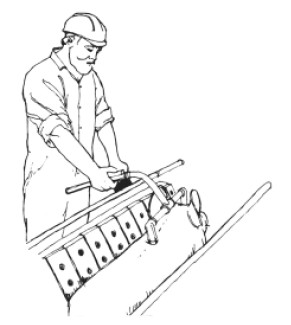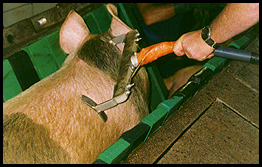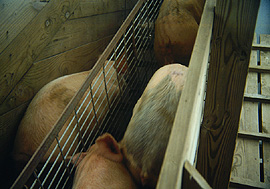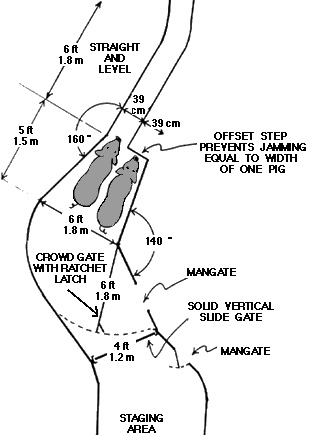Effective stunning methods are readily available to induce instantaneous insensibility. Good reviews on captive bolt stunning can be found in Leach (1984), Grandin (1994a) and Eikelenboom (1983). Electrical stunning methods used commercially on pigs and sheep are effective and induce instantaneous insensibility. A minimum of 1.25 amps must be passed through a pig’s brain to reliably induce insensibility (Hoenderken, 1982). In sheep, 1 amp is required (Gregory and Wotton, 1984).
Unlike pigs and sheep, a single current passed from the neck to the brisket failed to induce epileptiform changes in the electroencephalogram of cattle (Cook et al., 1993). In cattle, a split stun procedure is used. A 1.5 amp current must first be applied to the head before a head-to-body current is applied.(Gregory, 1993; OIE 2009). Reviews by Warrington (1974), Leach (1985),Grandin(1985; 1986; 2010; 2013) and Gregory (1994) provide further information.
To produce instantaneous, painless unconsciousness, sufficient amperage (current) must pass through the animal’s brain to induce an epileptic seizure (AVMA, 2013). Insufficient amperage or a current path that fails to go through the brain will be painful for the animal. It will feel a large electric shock or heart attack symptoms, even though it may be paralyzed and unable to move. When electric stunning is done correctly, the animal will feel nothing.
2013 recent questions about electric stunning
There have been many questions about the best way to determine that animals have been rendered insensible by electric stunning. If the animal has a true natural blink,it is NOT stunned correctly. A natural blink occurs when the eye makes a complete cycle of opening and closing. To test for a natural blink, wave your hand a few inches from the eye. A natural blink will look like a live animal in the stockyard. Research clearly shows that electric stunning MUST induce a grand mal epileptic seizure (Anil and McKinstrey 1991, Lambooy 1982, and AVMA 2013). Failure to induce a seizure will result in an animal that may be paralyzed and sensible to pain. In many countries, both regulations and guidelines state that a minimum of 1.25 amps must be passed through the brain. The original studies were done on small 100 kg (220 lb.) pigs. The larger pigs that are being processed today will often require a greater amperage setting.
The best electric stunners use an amperage-regulated circuit. The desired amperage is set and voltage varies. In the U.S. and other countries, there are older voltage-regulated units being used. In very small U.S. plants, these units are popular because they are much less expensive. With this type of unit, the desired voltage is set and the amperage varies. The question that has been asked is: Are voltage-regulated units humane? The bottom line is: regardless of circuit design, an electric stunner MUST produce an epileptic seizure. I have observed stunners with fake amperage meters, which makes it look like they are using the correct settings. There are also units available that change the frequency of the current to prevent blood splash damage in the meat. Higher frequencies reduce meat damage, but too high a frequency will fail to induce a seizure. Since it is impossible for plant personnel to all become electrical engineers, when I audit a plant, I look for clinical signs that the stunner is actually creating an epileptic seizure with a tonic (rigid phase) and clonic (kicking paddling) phase.
When an animal is correctly stunned for1 to 3 seconds with a reversible head only stun, a clear tonic and clonic phase of the seizure can be observed. If the stunner is held on for 30 seconds, the spine will become depolarized and the seizure will not be observed. This animal will be insensible provided that the stunner was capable of producing a seizure when applied for 1 to 3 seconds. When cardiac arrest stunning is used, the signs of a seizure are difficult to observe. Stopping the heart masks the signs of a seizure (Gilbert and Devine 1991). If a sequential stun is used where the current is applied to the head first and then a second current is applied to the heart, it is easy to determine that the stunner is working by delaying the heart stun for a few seconds to observe the tonic and clonic phase. The animal will remain insensible if the heart stun is applied before the clonic (paddling phase) stops. This will solve humane concerns about conducting this test. Failure to do this test would result in thousands of animals that may not be rendered insensible.
In many larger plants, simultaneous head to body stunning is used, where a current is passed through both the brain and the heart at the same time. Many of these units use proprietary amperage regulated and frequency regulated circuits. In most larger plants, the stunner is applied for 2 to 3 seconds. The short time makes it possible to see signs of a weak tonic and clonic phase. The clinical signs of the seizure are partially attenuated (reduced) by body stun. If I can observe a weak rigid and clonic phase, I know the stunner is working and inducing instantaneous insensibility. The trend in animal welfare is to use animal based outcome measures. The OIE and AMI minimum settings are a minimum baseline. I do not fully trust the meters because I have seen too many fake things and 1.25 amps may be too low for either large pigs or dehydrated animals. Animals that are dehydrated are more difficult to electrically stun. It is also not possible to safely train auditors and inspectors to open up electrical equipment and test it. To insure humane slaughter, looking at a meter is not sufficient to determine if electrical stunning is creating instantaneous insensibility. An inspector or auditor needs to see signs of a seizure.
 |
 |
Types of Stunning Wands
Simple, easy to build wand for electric stunning of pigs. The front electrode is placed behind the pig’s ear. It must not be placed on the neck. The front electrode is curved to fit the shape of the pig and it is 4 inches (10.5 cm) long and 1 inch (2.8 cm) wide.
There are two types of electric stunning, head only and cardiac arrest stunning, which stops the heart. Most large plants use cardiac arrest head to back or head to side of body stunning. It produces a still carcass that is safer and easier to bleed. Cardiac arrest stunning requires the use of a restraining device to prevent the animal from falling away from the stunning wand before it receives the complete stun. Cardiac arrest stunning kills the animal by electrocution. Head only stunning is reversible. Pigs and sheep which are stunned with a head only stunner must be bled within a maximum interval of 30 seconds to prevent them from regaining consciousness. An interval of 10 to 17 seconds is recommended.
When cardiac arrest stunning is used, one electrode must be placed on either the forehead or in the hollow behind the ears, and the other electrode is placed on either the back or the side of the body. The head electrode should not be allowed to slide back onto the neck. When head only stunning is used, the electrodes may be either placed on the forehead or clamped over around the sides of the head like ear muffs. Pigs should be wetted prior to stunning. The stunning wand must be applied to the animal for two to three seconds to stun properly. Stunners should be equipped with a timer.
(June 2008 Update): Many very small plants have problems with pigs or sheep returning to sensibility after head only stunning. Their hoist is so slow that bleeding within 10 to 15 seconds is difficult. For plants that use a head only stunner that has two prongs, the following procedure can be used. Apply to the head first to induce insensibility and then apply a second time to the side of the animal right behind the front leg (Vogel et al, 2010). This is a simple way to convert ahead only stunner to a cardiac arrest stunner. To reliably prevent return to insensibility, the heart shock must be applied immediately, within 15 seconds after the head stun. If stunning tongs are used, they can be clamped across the animals’ body or applied to the chest. THE HEAD STUN MUST BE DONE BEFORE THE STOPPING THE HEART CURRENT. Applying a second current to the chest abolished rhythmic breathing, righting reflex, eye tracking, vocalization (squealing), and natural spontaineous blinking (Vogel et al, 2010). The application of the chest electrode stopped the heart. For plants in the U.S. that use the Best and Donovan electric stunner, wand extensions are available to make the wand fit better on large pigs.
Prevention of blood spots
To prevent bloodspots in the meat and pain to the animal, the wand must be pressed against the animal before the button is pushed. The operator must be careful not to break and make the circuit during the stun. This causes the animal’s muscles to tense up more than once and bloodspots may increase. Stunning wands and wiring should be checked often for electrical continuity. A worn switch may break the circuit enough to cause bloodspots. Electrodes must be kept clean to provide a good electrical contact. Operators must never double stun animals or use the stunning wand as a prod.
Modern stunning circuits use a constant amperage design. The amperage is set and the voltage varies with pig or sheep resistance. Older style circuits are voltage regulated. These circuits are inferior because they allow large amperage surges which can fracture bones and cause bloodsplash. The distance between the head electrode and the back electrode should not exceed 14 inches. Pig stunners should be equipped with blunt electrodes which do not stick into the animal. The most modern sheep stunners from New Zealand utilize water jets to conduct electricity down through the wool.
Warris et al. (1994) found that pigs were more stressed in abattoirs with single file races compared to plants where pigs were stunned in small groups on the floor. The intensity of squealing was highly correlated with physiological stress measurements and PSE. Electrical stunning of pigs on the floor is most practical for abattoirs that slaughter under 240 pigs per hour. The author has observed that floor stunning often becomes rough and sloppy at higher speeds. In larger plants, a well designed race will produce less stress than a poor one. Weeding et al. (1993) found that both design and staff expertise affected stress levels in pigs. Pigs that jam in the race or are poked with electric prods will have higher lactate and poorer pork quality. The last five minutes before stunning is very critical. Excitement and agitation shortly before slaughter will lower pork quality and raise lactate levels (Edwards et al, 2010ab).
| Pigs move more easily through a ramp where they walk up side by side. The outer sides are solid and the middle partition is “see through” to promote following behaviour. |  |
 |
On the diagram illustrating a well designed pig race, the double chute is recommended. However, if space restriction is an issue, notice the diagram does promote pigs natural following behavior and prevents jamming with an offset step at the entrance of the chute. With the double chute design, the outer walls are solid, with a “see through” middle partition that further promotes following behaviour. |
Electric stunning renders the animal instantly unconscious by passing an electic current through the animal’s brain. When it is done properly, the animal does not feel pain.
Safety Tips for Workers
- The stunner operator’s station must be kept dry.
- Stunning wands should be designed so that they can be operated by one hand. Avoid designs where the two electrodes are held separately in each hand. These increase a shock across the chest electrocution hazard.
- The operator should wear rubber boots and stand on non-conductive plastic grating.
- The restrainer frame and worker walkway structure should be grounded to a perfect ground. However, the side of the restrainer that the stunner operator can touch should be covered with heavy insulating materials such as a plastic meat cutting board.


Greetings, I am so glad I found your webpage. I’m really appreciating the persistence you put into your blog and detailed information you offer. It is shockingly generous with people like you to provide publicly all that many individuals might have sold as an e book to get some dough on their own, even more so given that you might well have tried it in the event you decided. Please let me know if you’re looking for a article writer for your weblog. You have some really great posts and I think I would be a good asset. If you ever want to take some of the load off, I’d really like to provide some material for your blog in exchange for a link back to mine. Please shoot me an e-mail if interested. Thanks! By the Way, Grab Here
Hello Web Admin, I noticed that your On-Page SEO is is missing a few factors, for one you do not use all three H tags in your post, also I notice that you are not using bold or italics properly in your SEO optimization. On-Page SEO means more now than ever since the new Google update: Panda. No longer are backlinks and simply pinging or sending out a RSS feed the key to getting Google PageRank or Alexa Rankings, You now NEED On-Page SEO. So what is good On-Page SEO?First your keyword must appear in the title.Then it must appear in the URL.You have to optimize your keyword and make sure that it has a nice keyword density of 3-5% in your article with relevant LSI (Latent Semantic Indexing). Then you should spread all H1,H2,H3 tags in your article.Your Keyword should appear in your first paragraph and in the last sentence of the page. You should have relevant usage of Bold and italics of your keyword.There should be one internal link to a page on your blog and you should have one image with an alt tag that has your keyword….wait there’s even more Now what if i told you there was a simple WordPress plugin that does all the On-Page SEO, and automatically for you? That’s right AUTOMATICALLY, just watch this 4minute video for more information at. Seo Plugin